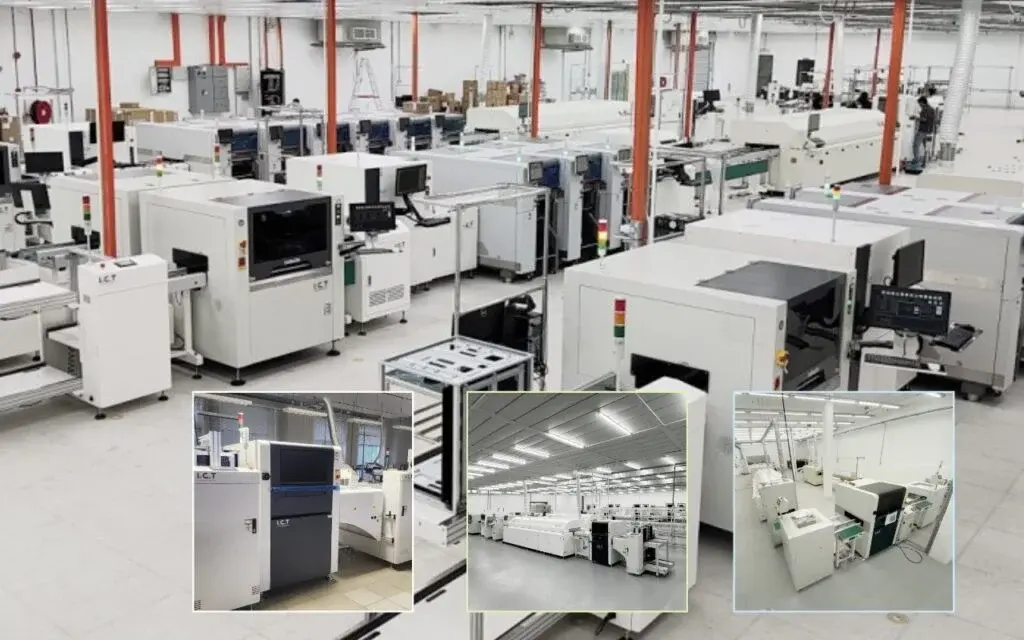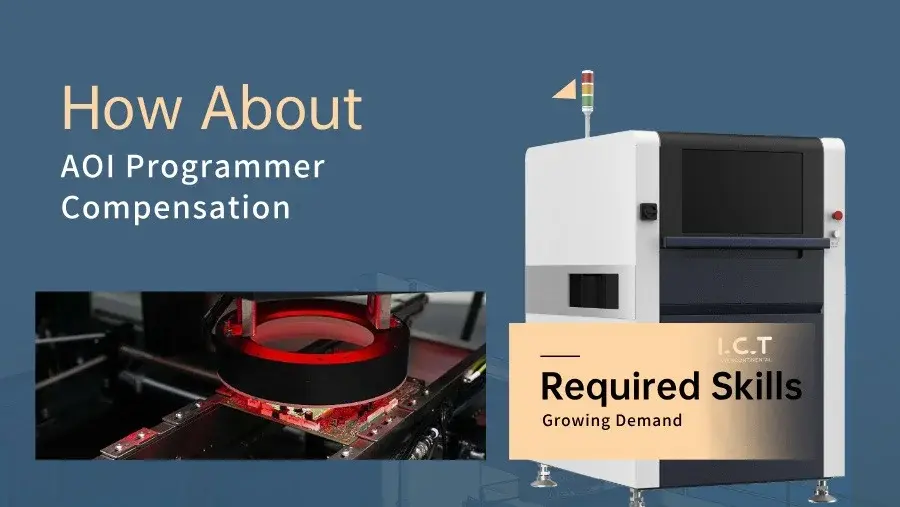Global demand for I.C.T SMT AOI machine underscores the critical role of AOI programmers in ensuring defect-free PCB in electronics manufacturing. These professionals develop and optimize algorithms for AOI systems, driving quality control in SMT lines. Salaries for AOI programmers vary widely by region, experience, and industry, reflecting the specialized nature of their work. This article explores compensation trends, key factors influencing earnings, and the role of leading brands like I.C.T in shaping career opportunities.
1. Understanding AOI Programmer Roles in the Electronics Industry
AOI programmers are integral to modern electronics production, particularly in SMT and PCB manufacturing. They design software that enables AOI machines to detect defects like misaligned components, soldering issues, or coating inconsistencies with precision. Their work ensures high-quality output in industries ranging from consumer electronics to automotive manufacturing, where even minor errors can lead to costly failures.
1.1 Core Responsibilities and Required Skills
AOI programmers create and refine algorithms for image processing, often using tools like C++, Python, or proprietary software from brands like Koh Young and Omron. They calibrate systems to minimize false alarms, integrate data with manufacturing execution systems (MES), and support remote debugging. Key skills include expertise in computer vision, familiarity with Convolutional Neural Networks (CNN), and knowledge of SMT processes. Proficiency with specific AOI platforms, such as I.C.T’s AI-5146, enhances employability, as these systems require tailored programming for optimal performance.
1.2 The Growing Demand Driven by SMT and PCB Production

The electronics industry’s shift toward miniaturization and high-volume production fuels demand for AOI programmers. Factories producing smartphones, automotive electronics, and LED products increasingly rely on advanced AOI systems to maintain quality. For instance, major manufacturers like Foxconn and Samsung deploy AOI machines post-reflow to catch soldering defects, creating steady job opportunities for skilled programmers.
2. Factors Influencing AOI Programmer Compensation
Compensation for AOI programmers depends on multiple factors, including experience, company size, and the complexity of the AOI systems used. Salaries also reflect regional economic conditions and the adoption of cutting-edge technologies like AI-driven inspection.
2.1 Experience Levels and Career Progression
Entry-level AOI programmers focus on routine tasks like system setup and basic algorithm adjustments, earning modest salaries. Mid-level professionals, with 3–5 years of experience, take on project leadership, boosting earnings by 20–30%. Senior programmers, often specializing in brands like I.C.T or CyberOptics, command top pay for optimizing complex systems and integrating AI algorithms, with salaries reflecting their strategic contributions.
2.2 Industry Sector and Company Size Effects
Large manufacturers like TSMC or Intel offer higher salaries due to their scale and use of premium AOI systems. Smaller electronics manufacturing services (EMS) providers may pay less but provide growth opportunities through diverse projects. Industries like automotive and aerospace, which demand stringent quality control, often pay premiums for programmers skilled in 3D AOI and conformal coating inspections.
3. Global Averages: Regional Salary Breakdown

AOI programmer salaries vary significantly across regions, driven by local manufacturing hubs, cost of living, and industry focus. Below is a detailed breakdown based on 2025 data from credible sources.
3.1 North America and Europe: High-Earning Markets
In the United States, AOI programmers earn an average of $82,000 annually, with hourly rates around $39.54 in tech hubs like California, where companies like Intel integrate advanced AOI systems. Western Europe, including Germany and Finland, offers salaries between €70,000–€135,000 ($74,628–$145,560), fueled by automotive and aerospace sectors using systems for PCBA inspections. Eastern Europe, such as Estonia, averages $40,000, balancing cost and expertise for consumer electronics production.
3.2 Asia: Opportunities in China, India, and Indonesia
China, a global PCB manufacturing leader, offers AOI programmers around $56,000 annually in cities like Shenzhen, where Huawei employs I.C.T and Koh Young systems for high-volume production. In India, salaries range from $17,000–$20,000 in Bangalore, driven by growing electronics parks. Indonesia averages IDR 200–500 million ($13,000–$32,000), supporting export-focused factories using AOI for LED and consumer goods.
3.3 South America and Emerging Regions: Growth Potential
In Brazil and Mexico, AOI programmers earn $25,000–$35,000 annually, supported by nearshoring trends and partnerships with U.S. firms. Countries like Uruguay, with smart meter production using I.C.T’s AI-5146, reflect growing investment in AOI expertise. Salaries in these regions are lower but poised for growth as manufacturing expands.
4. Leading Factories and AOI Brands in the Field
Major electronics manufacturers rely on advanced AOI systems, creating demand for skilled programmers. These factories use a mix of established and innovative brands, with I.C.T gaining traction for its versatile solutions.
4.1 Major Manufacturers and Their AOI Implementations
Foxconn, a global leader, integrates Koh Young’s 3D AOI for smartphone PCB inspections, requiring programmers to handle complex data outputs. Samsung employs Omron’s VT-S series post-reflow to ensure soldering precision, while TSMC uses CyberOptics for high-density boards. In Finland, automotive electronics makers leverage I.C.T’s AI-5146 for coating inspections, ensuring compliance with stringent standards. Tajikistan’s LED manufacturers and Estonia’s consumer electronics suppliers also adopt I.C.T systems for their efficiency and low false alarm rates.
4.2 Spotlight on I.C.T Brand: Features and Adoption

I.C.T offers advanced AOI solutions like the AI-5146, used in SMT, DIP, and conformal coating lines. These systems feature deep learning algorithms, dual-side cameras for simultaneous SMD and DIP inspections, and UV light for detecting coating defects as small as 0.05mm. Factories in Uruguay and Estonia benefit from I.C.T’s quick setup and MES integration, reducing downtime. The brand’s CE and ISO certifications ensure reliability, making it a preferred choice for programmers seeking roles in cutting-edge facilities.
5. Strategies to Maximize AOI Programmer Earnings
AOI programmers can boost their income through targeted skill development and strategic career moves, aligning with industry trends and employer needs.
5.1 Skill Development and Certifications
Mastering software for brands like I.C.T, Koh Young, or Omron enhances earning potential. Certifications in computer vision or AI programming, available through platforms like Coursera, add value. Familiarity with MES integration and 3D AOI systems, as used in TSMC’s lines, positions programmers for senior roles with 15–25% salary increases.
5.2 Negotiation Tips and Career Mobility
Programmers should highlight expertise in specific AOI systems during negotiations, especially for high-demand brands like I.C.T. Relocating to tech hubs like Shenzhen or California can increase earnings by 20–40%. Freelance opportunities in emerging markets like Brazil offer flexibility, while long-term contracts with global firms provide stability and benefits.
6. Summary of Key Insights
AOI programmer salaries reflect a dynamic global market, with North America and Europe leading at $40,000–$145,560, followed by Asia ($13,000–$56,000) and South America ($25,000–$35,000). Experience, industry sector, and expertise in brands like I.C.T drive earnings. Major manufacturers like Foxconn and Samsung rely on advanced AOI systems, creating steady demand. Programmers can maximize income through certifications, brand-specific skills, and strategic relocation.
The rise of AI-driven AOI systems and miniaturized electronics fuels job growth. Programmers should focus on mastering platforms like I.C.T AI-5146, pursue certifications, and consider opportunities in high-paying regions or emerging markets to optimize career prospects.
Also Read-Future Trends in Emergency Vehicle Technology










